Gerbil
Gerbils were named after jerboas, which are also rodents. Jerboas look like gerbils but are not closely related to them.
Advertisement
Gerbil Scientific Classification
Read our Complete Guide to Classification of Animals.
Gerbil Conservation Status
Gerbil Facts
- Prey
- Insects, bird nestlings, other gerbils
- Name Of Young
- Pup
- Group Behavior
- Flocks
- Fun Fact
- Gerbils were named after jerboas, which are also rodents. Jerboas look like gerbils but are not closely related to them.
- Estimated Population Size
- Unknown, though some species are endangered
- Biggest Threat
- Snakes, birds of prey, carnivores, humans
- Most Distinctive Feature
- Their ability to jump. Some gerbils can jump as far as 11.5 feet.
- Other Name(s)
- Gerbillines
- Gestation Period
- Three to four weeks if the female is not nursing, longer if she is.
- Litter Size
- One to 13 babies
- Habitat
- Deserts and other arid places, though some gerbils are found in pastures, woodlands, scrub forests and mountain valleys.
- Predators
- Owls, vultures, snakes, foxes, other carnivores
- Diet
- Omnivore
- Average Litter Size
- 8
- Lifestyle
- Solitary
- Favorite Food
- Seeds
- Type
- Mammal
- Common Name
- Gerbil, jird, tateril, doop
- Number Of Species
- 110
- Location
- Asia, Africa and the Middle East
- Slogan
- Originally known as the Desert Rat!
- Group
- Colony, horde
Gerbil Physical Characteristics
- Color
- Brown
- Grey
- Red
- White
- Orange
- Pink
- Olive
- Skin Type
- Fur
- Top Speed
- 6.7 mph
- Lifespan
- Three to four months in the wild to eight years in captivity
- Weight
- 0.35 to 8 ounces
- Length
- 6 to 16 inches long, including the tail
- Age of Sexual Maturity
- 10 to 16 weeks
- Age of Weaning
- One month
View all of the Gerbil images!
“The Gerbil is the cute and lovable rodent cannibal!”
Gerbils belong to a subfamily in the Rodentia order called Gerbillinae. This subfamily includes jirds. Jirds belong to different genera than rodents formally known as gerbils, but sometimes the animals are interchangeable. Indeed, the most popular, the Mongolian gerbil, is also referred to as the Mongolian jird.
See all of our expert product reviews.
Four Incredible Gerbil Facts!
Some facts about gerbils include:
- Though there are well over a hundred species, the one most commonly kept as a pet is the Mongolian gerbil.
- The tail of the fat-tailed gerbil is shorter than those of others and shaped like a club. It’s also nearly hairless. It is used to store water and fat for hard times.
- The largest one is the great gerbil, which can grow to 16 inches in length. It’s found in central Asia. It’s also a reservoir species for the plague.
- Most species are diurnal, or they operate during the day. Exceptions are Cheesman’s gerbil, Setzer’s hairy-footed gerbil, and Boehm’s gerbil, which is nocturnal. Cheesman’s gerbil is found in the Middle East, Setzer’s hairy-footed gerbil is found in Africa’s Namib Desert and Boehm’s gerbil is found in several countries in Africa.
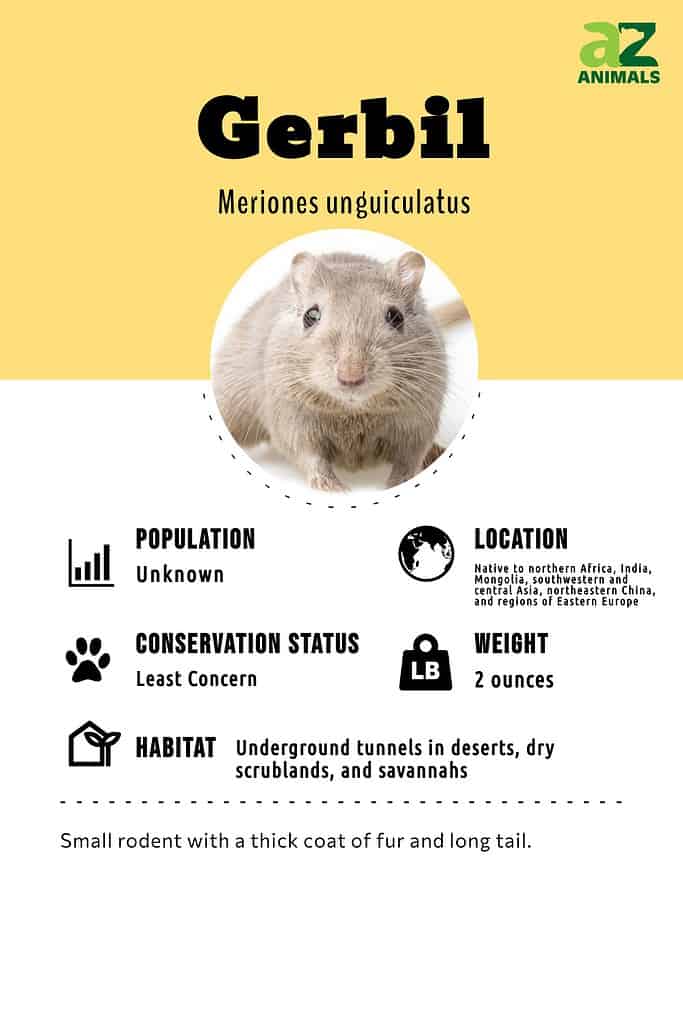
Scientific name
Different species have different scientific names, but all belong to the Muridae family and the Gerbillinae subfamily. Besides the 110 or so species, there are about 16 genera. The meaning of the Mongolian gerbil’s scientific name Meriones unguiculatus is “clawed femur” in Greek. The fat-tailed gerbil’s scientific name is Pachyuromys duprasi. Pachyuromys is a Greek word whose meaning is “fat-tailed mouse.” It is the only member of its genus. Some other gerbil species are:
- Jirds (Meriones rex)
- Northern pygmy gerbils (Gerbillus pulvinatus)
- Bushy-tailed jird (Sekeetamys calurus)
- African naked-soled gerbils (Gerbilliscus leucogaster)
- Hairy-footed, or southern pygmy, gerbils (Gerbillurus paeba)
- Small naked-soled gerbils (Taterillus gracilis)
- Ammodile, or walo (Ammodillus imbellis)
- Pygmy gerbils (Dipodillus harwoodi)
- Somali pygmy gerbil (Microdillus peeli)
- Przewalski’s gerbil (Brachiones przewalskii)
Evolution And History
Gerbils belong to the family Murdiae which is in the order Rodentia. Their closest relatives are an extinct species belonging to the genus Myocricetodon. Fossils representing this extinct genus were found in Africa and Eurasia dating back to 16.4 million to 11.2 million years ago, during the Miocene era.
The first time a gerbil was ever mentioned in history was in the 1860s. They were discovered in northern China by a missionary Father Armand Davis, who thought they were yellow rats and sent them to the National Museum of Natural History in Paris. The scientist Alfonse Milne-Edwards then gave them the name Gerbillus unguiculatus. Belonging to their own specific subfamily, the most common gerbil of today, the Mongolian gerbil originated from wild specimens that were captive and held in Japan at the Kitasato Institute. In 1954, doctor Dr. Victor Schwentker imported some of these gerbils to the United States and established a colony at Tumblebrook Farm in New York.
Appearance
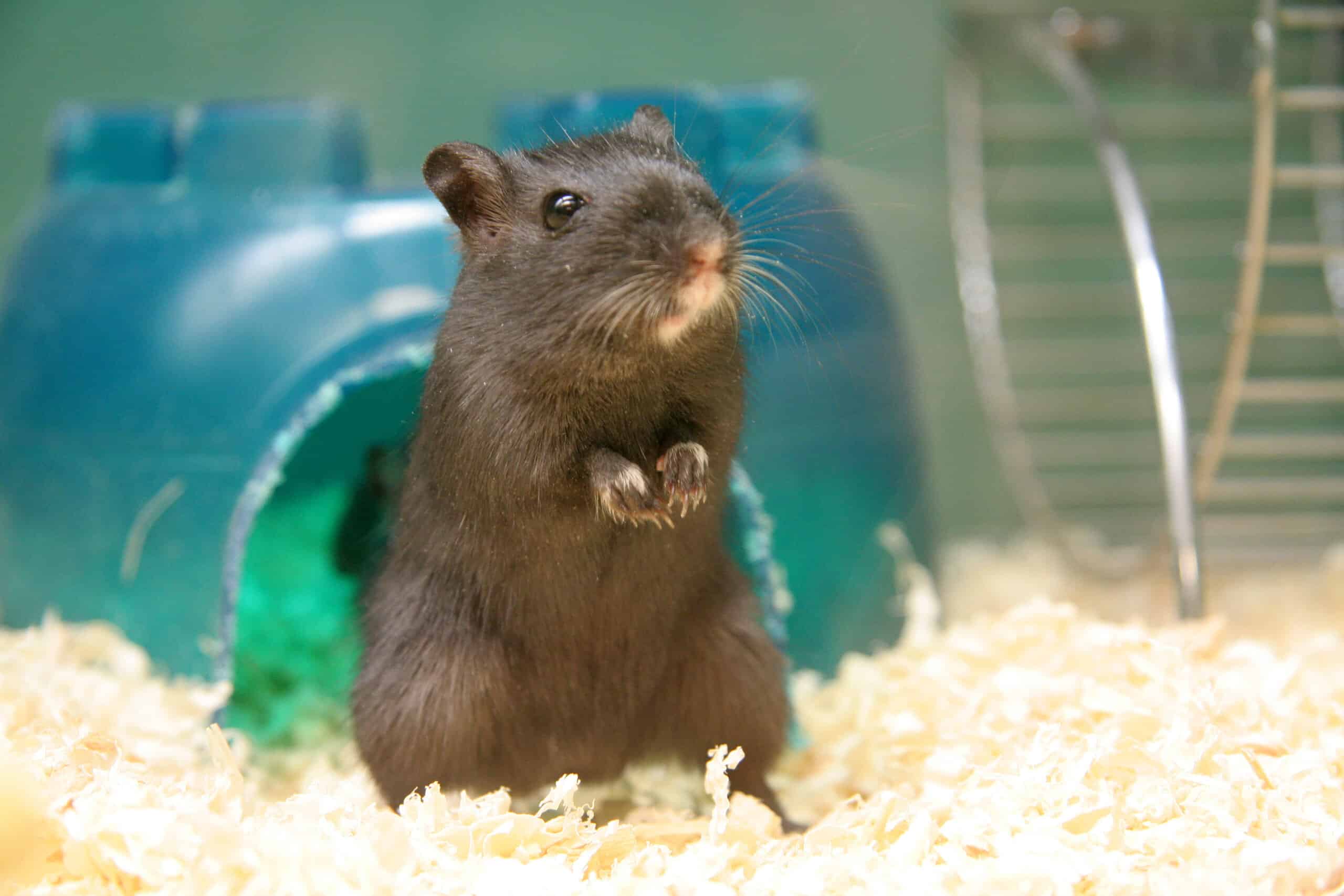
This is a small rodent with thick fur and a long tail.
Health and Entertainment for your Gerbil
See all of our expert product reviews.
©iStock.com/Devonyu
The gerbil is a small rodent with a thick coat of fur. In some animals, the fur is soft while in others it is harsh. The coat is usually of neutral colors to help the animal blend in with its surroundings, for they are the favorite food of all manner of carnivores. Whatever colors the topcoat has, the underparts are usually white or buff. These rodents range in size from 6 to 16 inches and weigh between 0.35 and 8 ounces.
The tails are often half the length of the body or more. One exception to this is the fat-tailed gerbil, whose tail is round and, in a healthy animal, fat and nearly hairless. In some species, males are bigger, while in others, the sexes are about the same size. The back feet of most species are long and narrow and made to help the animal jump. They also have long claws to help them dig. The ears of some of them are small while others have longer ears.
Because so many animals prey on them, a gerbil’s life expectancy in the wild may only be a few months. However, a pet gerbil who gets good care can live to be eight years old. This is especially true of the fat-tailed gerbil, whose lifespan may be that long with proper care.
Behavior

Gerbils are social animals and should be with at least one other gerbil to prevent loneliness.
©iStock.com/CamiloTorres
The Mongolian gerbils that are kept as pets are social animals, and it is important that an owner buy at least two from the same litter to prevent loneliness in a single animal. Though most species are diurnal, some are active at twilight, others come out at night and some are active both day and night. They are fossorial animals that dig out burrows with chambers that serve different functions. One chamber may be for storing food, another for sleeping, and another used as a chamberpot.
Gerbils that are social, interact with each other intensely. They groom, play, and play-fight with each other and snuggle together for warmth when it is time to go to sleep. Sometimes real fights break out if the burrow starts to become overcrowded. Though these rodents are social, they’re also territorial, and pet owners should introduce two unrelated animals to each other with great care. It’s not unheard of for gerbils to fight to the death.
Young gerbils may leave the burrow and wander about until they can find their own home range. Unlike kangaroo rats, they need water, and they’ll leave their home range if there’s a drought. They don’t hibernate but can enter a state of torpor and live in their burrows for a long time when the temperature drops. They have extremely good hearing, and good vision and use a variety of vocalizations, including squeaks, grunts, clicks, rattles, and shrieks. They’ll sometimes drum their hind feet on the ground if they’re agitated.
Habitat
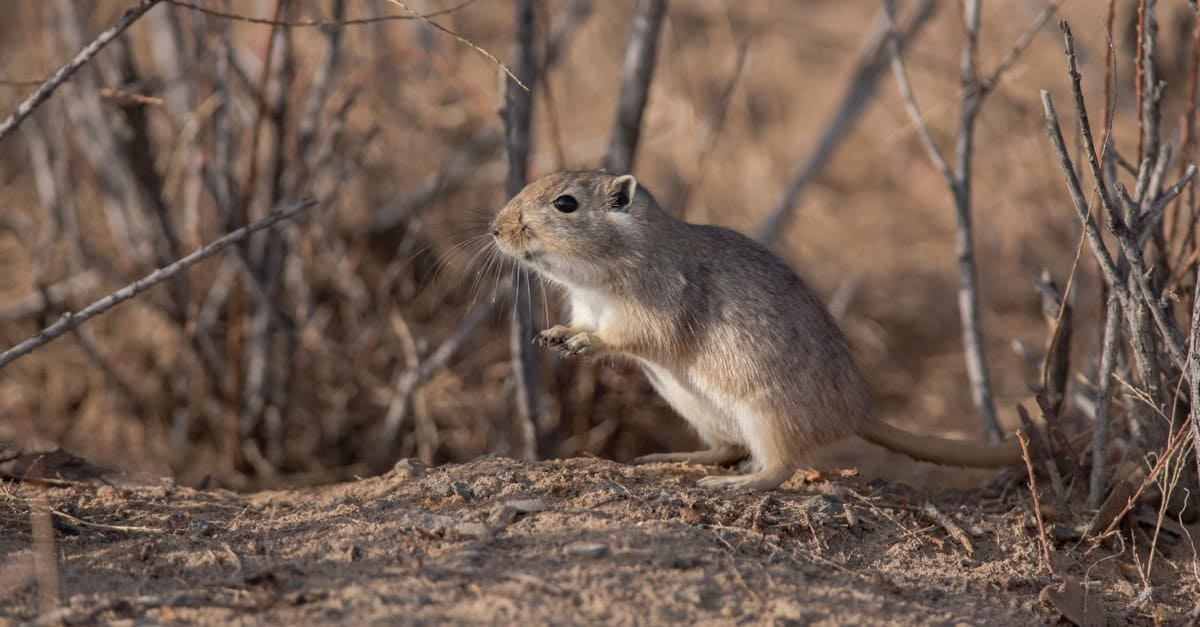
Gerbils are endemic to certain areas of Africa, China, South Africa, India, Asia, Mali and Eastern Europe.
©Wildpix productions/Shutterstock.com
Most species live in dry areas such as deserts, rocky areas, or dry savannahs, though there are exceptions such as the Gorongoza gerbil which lives in moist savannahs of southeastern Africa. Some of them are endemic to one country. For example, Przewalski’s gerbil is found only in China, the Cape Gerbil is found only in South Africa, the rupicolous gerbil is endemic to Mali, and Cheng’s jird is only found in the Turpan Depression in the autonomous region of Xinjiang in China.
When it comes to habitat for a pet, it’s best to give these rodents as large an enclosure as practicable, for they are active creatures. Glass-fronted aquariums are ideal for them as opposed to wire cages because a lot of bedding can be laid down and encourage the gerbil to dig. These rodents can also injure themselves on the wires of wire cages, and they will also chew on cages made of plastic. They also need a nest box where they can hide and sleep. It’s best that it be made of ceramic, and a terracotta flower pot may be just the thing.
These rodents also need toys, but these toys should not be made of plastic or anything that is hazardous to chew on. Besides toys, they benefit from an exercise wheel. The temperature for an enclosure is ideally between 68 and 75.2 degrees Fahrenheit. Never put the gerbilarium in direct sunlight.
Diet
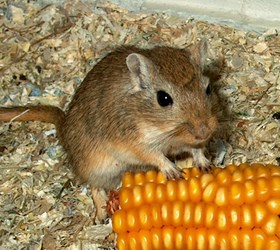
Gerbils like to eat both plant and animal material but they are not above cannibalism.
Another fact about gerbils is that they are omnivorous, which means they’ll eat both plant and animal material. They readily eat seeds, nuts, roots, grass, and fruit. In the wild, they’ll eat bird’s eggs, newly hatched chicks, and insects. They are not above cannibalism.
A pet owner can feed commercial food, but gerbils do have a habit of picking out what they like and ignoring everything else. Pellets may be better since the animal can’t discard what it doesn’t like. Treats can be given to train a gerbil or help it build trust in its owner. These include raisins or currants, nuts once in a while, sunflower seeds, which they covet, and mealworms. Some owners let their pets chew on little dog biscuits, as it keeps the rodent’s teeth filed down.
Predators And Threats
Most wild gerbils have a slew of predators to hide from. They range from owls to foxes to snakes. Some species are still hunted by humans for their fur. Others are endangered by human development and climate change. They are also prey to several types of parasites, including fleas.
Reproduction And Life Cycle
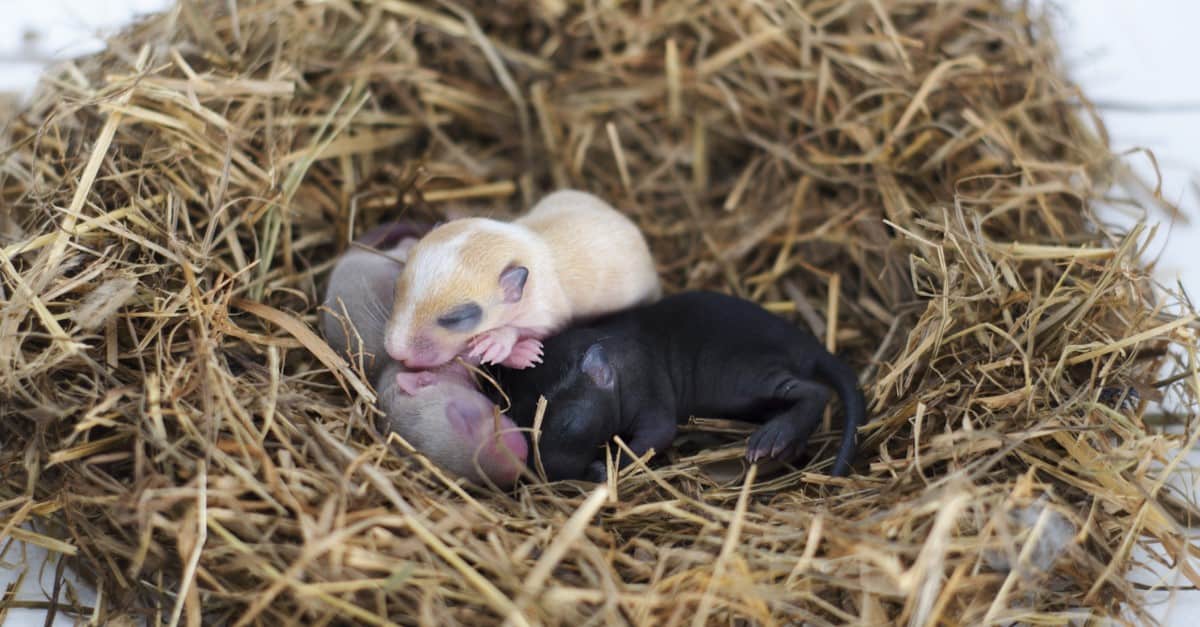
Baby gerbils develop quickly. Their fur begins to grow between 8 and 13 days after they’re born.
©February Sweet/Shutterstock.com
Some members of the Gerbillinae subfamily breed all year round while some have definite breeding seasons. What’s true of most females is that they are polyestrous, meaning they cycle into estrus throughout the year and can give birth to more than one brood a year. They may come into estrus right after they give birth and may still be nursing the first brood while gestating the second.
Females give birth to an average of four to seven pups that are born helpless. Yet they develop quickly. Their fur starts to come in between eight and thirteen days after they’re born, and by the time they’re about two weeks old, they are completely furred, though their eyes are still closed. Yet, about a week after their fur comes in their eyes open, and they can run around and explore. They’re weaned and independent when they’re a month old and are mature when they’re two and a half to four months old.
Mothers move their babies from nest to nest during their first few days of life, and she will change burrows to give birth to a second brood. She grooms the pups assiduously, and in some species, the father does so as well.
One of the sadder facts about Mongolian gerbil mothers is that they tend to abandon their pups if they only have one or two, and if she loses her mate, she will most likely not mate again. A Mongolian gerbil kept as a pet has an average lifespan of three or four years.
Population
Though the overall population of these rodents is unknown, it is possibly in the hundreds of thousands simply due to the great number of gerbil species and the fact that female gerbils can have several broods a year. The data for many species of gerbils have not been collected. However, there are still gerbils that are endangered. They include the Principal gerbil, which lives in Sudan and whose numbers may be as few as 250 individuals in the wild. Cheng’s jird is also critically endangered, and Arabian, Dahl’s, Buxton’s, and Zarudny’s jirds are endangered. The ammodile, or Somali gerbil is under threat due to habitat loss.
View all 170 animals that start with GGerbil FAQs (Frequently Asked Questions)
Are Gerbils herbivores, carnivores, or omnivores?
Gerbils are omnivores.
What Kingdom do Gerbils belong to?
Gerbils belong to the Kingdom Animalia.
What class do Gerbils belong to?
Gerbils belong to the class Mammalia.
What phylum to Gerbils belong to?
Gerbils belong to the phylum Chordata.
What family do Gerbils belong to?
Gerbils belong to the family Muridae.
What order do Gerbils belong to?
Gerbils belong to the order Rodentia.
What type of covering do Gerbils have?
Gerbils are covered in fur.
In what type of habitat do Gerbils live?
Gerbils live in dry deserts.
What is the main prey for Gerbils?
Gerbils eat seeds, fruit, and nuts.
What are some predators of Gerbils?
Predators of Gerbils include birds, snakes, and wildcats.
How many babies do Gerbils have?
The average number of babies a Gerbil has is 8.
What is an interesting fact about Gerbils?
Gerbils were originally known as the Desert Rat!
What is the lifespan of a Gerbil?
Gerbils can live for 3 to 5 years.
How fast is a Gerbil?
A Gerbil can travel at speeds of up to 4 miles per hour.
What is a gerbil?
A gerbil is a type of rodent that belongs to the Muridae family and the Gerbillinae subfamily.
Where do gerbils live in the wild?
Gerbils usually live in dry places such as deserts, dry scrublands, and savannas. Yet they can’t live in places that almost never get rain, for they do need water.
Where do gerbils come from?
Gerbils come from Asia, Africa, and the Middle East.
Are gerbils good pets to have?
Gerbils are good pets to have for someone who can properly care for them. They are clean, gentle, and easy to take care of. They need a gerbilarium that’s the right temperature and has enough bedding to burrow into, food and fresh, clean water, toys to keep them busy, a wheel to let them exercise, and a playmate to stave off loneliness.
Are gerbils nicer than hamsters?
Gerbils are much nicer than hamsters. Gerbils like to be petted or at least tolerate it, but hamsters do not and tend to bite.
Is a gerbil a rat?
Gerbils aren’t rats, even though both rats and gerbils are rodents.
Do gerbils bite?
Overall, gerbils don’t bite unless they feel really threatened.
What does a gerbil look like?
A gerbil is furry, with large, dark eyes and a long tail that’s sometimes the length of its body. Unlike many mice and rats, the tails of most gerbils have fur.
What is the difference between a gerbil and a hamster?
The most notable difference between a gerbil and a hamster is that a gerbil has a long tail. Hamsters have stubby tails and are also larger and fatter than gerbils. They are nocturnal while most gerbils are diurnal. Gerbils are often social while hamsters are solitary and can’t tolerate each other outside of the mating season. The hamster’s life expectancy is also not as long as a pet gerbil’s. Hamsters can be expected to live two years, while a gerbil’s lifespan can be as long as eight.
What are the differences between Guinea pigs and Gerbils?
The major differences between Guinea pigs and gerbils are size, diet, behavior, and temperament.
What is the difference between a gerbil and a mouse?
The main differences between a gerbil and a mouse are that gerbils have hair on their tails, are native to Mongolia and China, and dig deep burrows in the desert. Mice have hairless tails, are an invasive species worldwide, and generally require a human presence to survive.
Thank you for reading! Have some feedback for us? Contact the AZ Animals editorial team.
Sources
- Valley Animal Hospital, Available here: https://valleyanimal.net/general/pocket-pets-gerbils-vs-hamsters/
- Animal Diversity Web, Available here: https://animaldiversity.org/accounts/Gerbillinae/
- The Spruce pets, Available here: https://www.thesprucepets.com/gerbils-4162084
- RSPCA, Available here: https://www.rspca.org.uk/adviceandwelfare/pets/rodents/gerbils/environment
- Wikipedia, Available here: https://en.wikipedia.org/wiki/Principal_gerbil

















